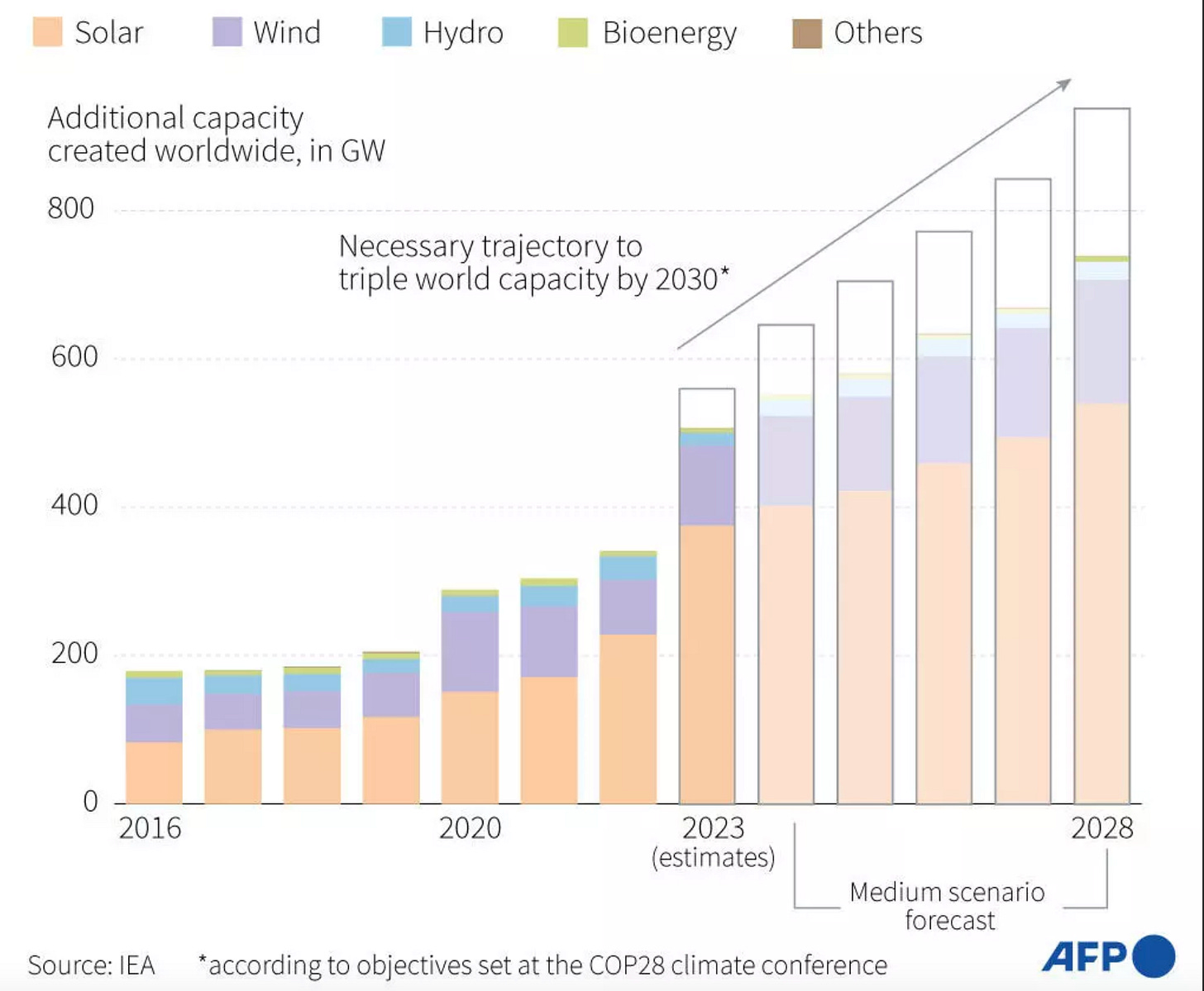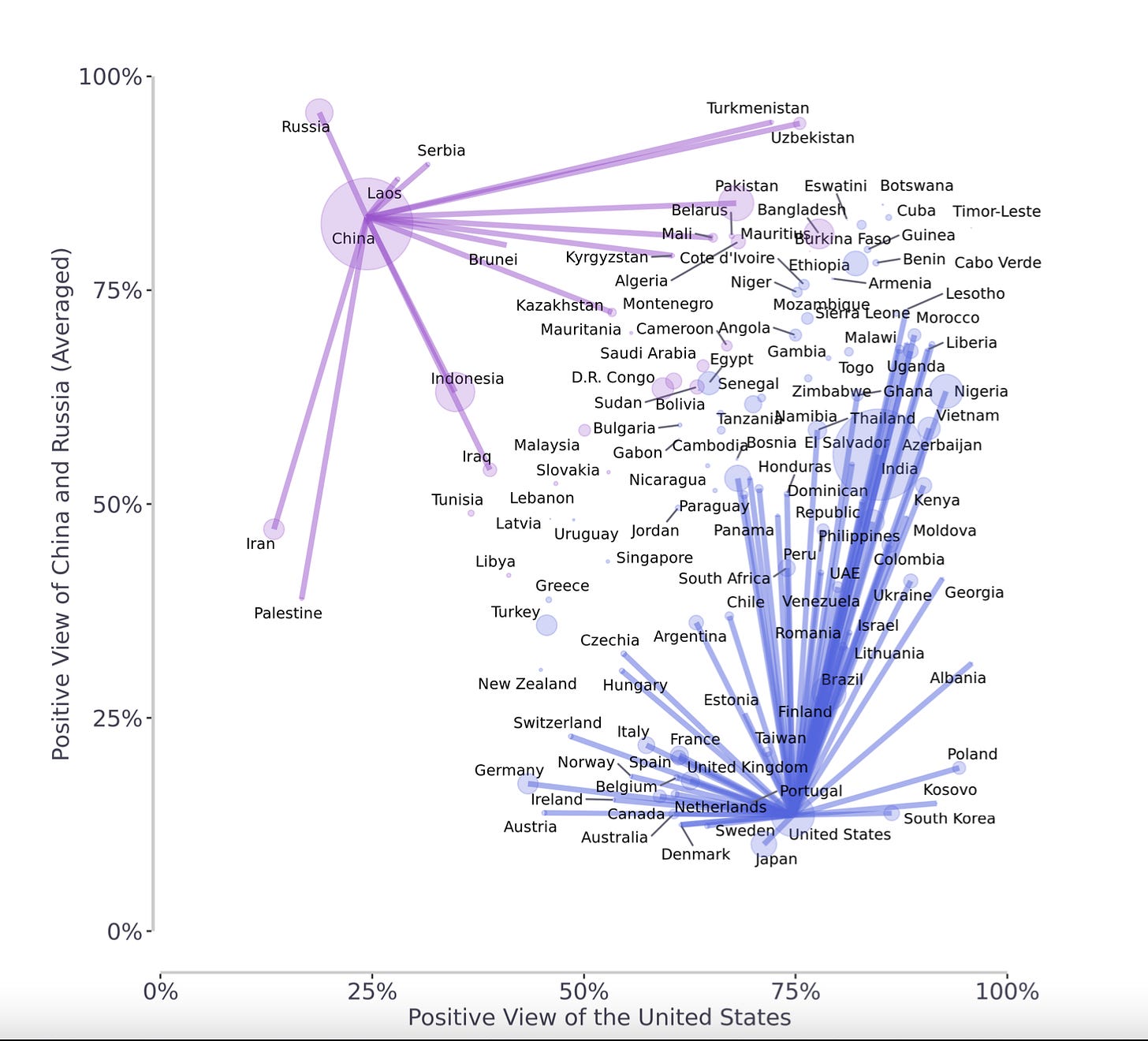Last week Taiwan elected a new president. Someone who is not friendly to China and the unification of China and Taiwan. Luckily, the CCP has not yet applied any sort of military pressure over Taiwan and seems to be interested in keeping relations cool with the U.S. This is great news!
The U.S. Navy, as well as the British, continue to hammer and degrade the capabilities of the Houthis in Yemen. Even though the closure of the Red Sea impacts the Gulf States, China, and Europe much more than the U.S., we continue to be the only country capable of policing the ocean and safeguarding global trade. Regardless of how domestic commentary tries to spin this (all depending on if you are pro or against Biden), the reminder of the ability of the U.S. to protect the trade of other nations will be a big win once the Houthis are neutralized.
I hope you all are staying warm and staying sane. This year is just getting started.
Articles Highlighted This Week:
World added 50% more renewable energy but more needed: IEA (France24)
Chinese Lab Mapped Deadly Coronavirus Two Weeks Before Beijing Told the World, Documents Show (WSJ)
A World Divided: Russia, China and the West (Cambridge University)
In charts: how India has changed under Narendra Modi (FT)
Energy and Materials:
World added 50% more renewable energy but more needed: IEA (France24)
TLDR: As the prices for renewables fall, countries all over the world are adding renewable capacity at all time highs. China is leading the world effort for renewable additions.
Why Is It Important? Renewable energy adds resiliency to countries that rely on energy imports to function. The quicker the world adds renewable energy sources, the quicker the power decreases from the energy exporters.
The pace of additions to renewable energy continues to grow and make new all time highs. However, the countries who add the most are not moving forward for the global good, but instead because of self interest.
China which added more solar capacity in 2023 than the entire rest of the world did in 2022 is by far the leader in renewables. This is for two primary reasons. The first is that the CCP wants China to lead in the energy transition and has invested billions of dollars in building out the various components needed to service this mega-trend (mining, construction, manufacturing, exporting, etc.) The second reason is that China wants to move as quickly away from any dependencies it has on the rest of the world, which in its energy needs are vast. China imports most of its energy so becoming self-reliant in this critical dimension unlocks much more flexibility on the international stage while also insulating itself from potential blow back on moves it may or may not pursue in the future (focus is on the Taiwan strait here.)
China is not the only one investing in the energy transition. The U.S., Europe, and Brazil also hit all-time highs in commissioning new renewable energy projects in 2023. In the U.S., most renewable energy projects are actually in Republican States. On the surface, this is ironic since most climate activists are Democrats. However, the economics of both solar and wind have gotten to the point where they are more competitive than traditional fossil fuel sources. Hence, the Republican and generally more pro business States are leading the charge in building out the U.S. renewable energy capacity.
The lesson for me is that economics and self-interest are still the most important levers to pull if we want humans to affect change on a mass scale. The imperative to protect our environment is understood by most humans, but if we want people to act we should focus on highlighting how it is in their self-interest to do so.
America and China:
Chinese Lab Mapped Deadly Coronavirus Two Weeks Before Beijing Told the World, Documents Show (WSJ)
TLDR: A Chinese scientist mapped and uploaded the COVID virus to a health database run by the U.S government on December 28th, 2019. It was subsequently deleted and not acknowledged by the CCP for another two weeks.
Why is it important? It is now estimated that 3M people died of COVID-19 in 2020 alone. The CCP has been obstructing the truth since 2019 which makes it impossible to fully learn the lessons of what went wrong and how to prevent it in the future.
This is a topic that will not be forgotten or ignored by anyone who lived through 2020. The actions of the CCP caused COVID-19 to be a global pandemic with consequences that will be felt for decades. As we find out more about the crucial first months of the spread of the disease, it becomes more apparent that the CCP holds indirect responsibility for the deaths of millions of people around the world.
There is no statute of limitations for the lives of millions of people. If the attempted cover-up in 2019/2020 is not addressed and corrected, we may find ourselves no better off in stopping another pandemic from going global in the future. China and the world will be safer if we actually learn the lessons from COVID-19 instead of continuing to obfuscate the truth.
Our Global Village:
A World Divided: Russia, China and the West (Cambridge University)
TLDR: The world is increasingly dividing into two camps. One led by the U.S which represents a liberal maritime order and the second that is led by China/Russia which represents an illiberal continental order.
Why is it important? The changing dynamics of the world order will have an impact on how we cooperate on humanities biggest issues. Understanding these dynamics will be crucial for diplomats that want to successfully pursue goals that are global in scope.
This is an important study in understanding the relative influence and change in perceptions toward the U.S, China, and Russia across the world. The implications are far reaching and will shape the global system for decades to come. The map below is a valuable tool in understanding where the U.S. can more easily find willing partners (Poland and South Korea), which countries are going to chart their own middle path (Turkey and Indonesia), and which countries are going to support China/Russia regardless of what the U.S. does (Serbia and Laos).
The following are some key findings highlighted by the report:
The world has divided into liberal and illiberal spheres. Among the 1.2bn people who inhabit the world’s liberal democracies, three-quarters (75%) now hold a negative view of China, and 87% a negative view of Russia. However, for the 6.3bn people who live in the rest of the world, the picture is reversed. In these societies, 70% feel positively towards China, and 66% positively towards Russia
China is now ahead in the developing world. For the first time ever, slightly more people in developing countries (62%) are favourable towards China than towards the United States (61%). This is especially so among the 4.6bn people living in countries supported by the Belt and Road Initiative, among whom almost two-thirds hold a positive view of China, compared to just a quarter (27%) in non-participating countries.
The real terrain of Russia’s international influence lies outside of the West. 75% of respondents in South Asia, 68% in Francophone Africa, 62% in Southeast Asia con- tinue to view the country positively in spite of the events of this year.
In charts: how India has changed under Narendra Modi (FT)
TLDR: Narendra Modi is going to face an election this year. India has improved in measurable ways over his time as prime minister, but it has not all been positive.
Why is it important? India is increasingly viewed as the country that can be a counter-weight to China in the Indo-Pacific. If the U.S. blindly builds up India only as a counter to China while ignoring its problematic behavior, we will set ourselves up for problems in the near future.
The rise of India is undeniable. It is now the most populous country with the fifth-largest economy in the world. Unlike the other top ten economies, it continues to grow at high single digits every year. The amount of Indians living in poverty has fallen from nearly ~20% in 2015 to roughly 12% in 2021. India has also been increasingly investing in its physical and digital infrastructure to improve its ability to attract foreign investment. All of this, coupled with the sharp reverse in the allure of China, has combined to make India increasingly one of the most interesting countries for investors, businesses, and diplomats alike.
Similarly to how the rise of China in the late 20th/early 21st century was the main driver of both geopolitics and globalization of the last 30 years, the rise of India will be the biggest geopolitical development in the 21st century. It is important for Westerners to study and try to understand India on its own and not just in the context of a counterweight to China. Anyone who thinks that the rise of India won’t cause problems, similar to how most globalists viewed the rise of China in the 90s as an unmitigated good, is going to wake up in a few decades blinded by developments that are already visible.
A lot can be said about India and the potential issues that may arise for foreigners who are investing in it today. I have already written about its more aggressive actions of allegedly plotting assassinations or attempted assassinations of Sikh minority leaders in Canada/the U.S. in the last few months. It is also widely known that the treatment of Muslims in India (who make up 18% of the population) has been worsening. Both socially and legally. These and many other topics are worth paying attention to. However, the issue and graph I want to highlight is the decline in India’s press freedom ranking under Narendra Modi.
In a world that is moving towards a splitting between liberal and illiberal governments, a turn to more authoritarian rule will diminish the main advantage India has over China. An important pillar in the checks and balances of a democracy is the freedom of the press to criticize its government. It has been reported that journalists in India are “encouraged” to highlight positive stories about both Modi and the BJP party that he leads. When journalists are critical of the government they face issues. An example,
“The BBC’s India head office and Indian news website NewsClick were raided in 2023, and journalists from other organizations have faced criminal charges or jail time in what watchdog groups describe as a crackdown on free expression.”
India is now barely above Russia in its press freedom ranking. If India wants to attract foreign capital from the capital-rich part of the world (aka the “West”) it needs to reverse this trend and become more open, even if it means that criticism gets surfaced to people's attention. The BJP and Modi have been a strong and growing force in Indian politics for decades. They represent a Hindu Nationalist movement that makes one's religion central to their Indian citizenship. If they really want to make India the great power that it can be, they should embrace the openness and diversity of the country instead of turning to more authoritarian tactics in their quest to make Hinduism central to the state of India.





some indians translate Modi as "murdered of democracy in Indiia". Its very telling.
Thanks for article.
Very interesting article. I enjoyed the portion on the transition to renewable energies. The one question I have is how much of the development of renewable energy being more concentrated in republican states is due to a majority of republican ran states being in warmer climates where renewables have less issues and generate more energy? Overall great to see more development of renewable energy sources and can only hope for further acceleration of the rollout of them.